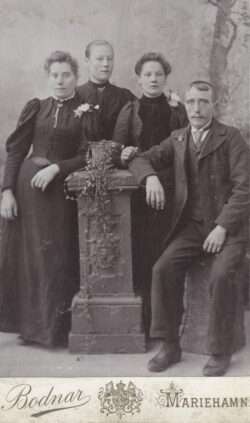
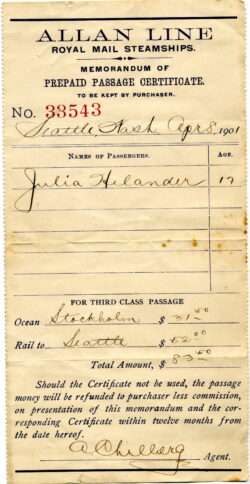
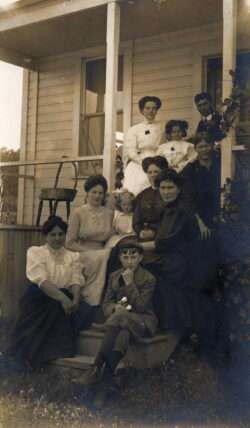
by Sylvia Stauffer
I remember my grandmother as frail most of the time, but her across-the-street neighbor told me some years ago about how startled she was one day to see Mrs. Clark up in her front-yard apple tree, pruning maybe or picking fruit. That would have been in the early 1950s when my grandmother Emelia Helander Clark was in her seventies. The house was in north Ballard where in 2008, I was doing the final clearing out of a home that my grandmother and aunts had lived in for nearly sixty years. The house with the beautiful piano and the tall dresser full of embroidered linens, photographs, and letters written in Swedish in a delicate thin hand, packed away gently by my grandmother so long ago. When young, Emelia probably spent plenty of time in fruit trees or doing other farm chores, growing up as the youngest of five children on a farm on Åland Island. Her father, Eric Ulric Helander (1848-1914), was a seafarer and tenant farmer or crofter who did all he could to support the family. But farming was not the only trade in the family — Eric’s father was known as the excellent tailor who always wore a silk hat.
The Helanders of the Åland Islands, Finland, and their ancestors lived on this small contested island in the middle of the Baltic Sea for many generations, going back at least to the 1700s. Some of these ancestors would have lived through long periods of war, starvation, and strife, being invaded and occupied for hundreds of years. When Åland’s neutrality, autonomous status with Finland, and the right to maintain Swedish culture were recognized by the League of Nations in 1921, my grandmother and her Åland relatives had all been in the United States for nearly twenty years. I wonder what she and her sisters thought at the time of the changes happening in their homeland and for its Swedish-speaking people. Emelia and her sisters had several friends from Åland in the Seattle area and must have heard some news about it all. I imagine they would have been very surprised to hear Åland Island was now a part of Finland as we had always heard that they came from Sweden.
My grandmother on my father’s side came to Seattle in 1906 to join her two older sisters, who had already settled and married in Seattle in previous years. Much of what we know about the Helander family is contained in a four-page account typed up by my aunt Vivian Clark in 1966. In this account, Vivian refers to my grandmother Emelia Clark as “Mother.” The text here is as Vivian wrote it in 1966, three years before my grandmother’s death.
“THE FOLLOWING INFORMATION WAS GIVEN to M. Vivian Clark by Mother during the winter of 1965—1966 when she was 81 years of age. She sat there and watched me as I did so, for in the event of her death, she wanted the family to have the correct facts about her. The spelling of names and places are primarily based on the pronunciation Mother used in describing these places and individuals to me.
Mother’s Mother — Amanda Serafia Nordstrom was born about 1844 and was the illegitimate daughter of LOUISA NORDSTROM and ERNEST SERANDER, a French judge. She had black eyes and hair and was considered to be one of the most beautiful women on Åland Island. Louisa Nordstrom and her daughter Amanda Serafina Nordstrom stayed and worked on this Estate called BOSTOR. There were three such places on Åland island: BOSTOR (where Amanda was born), KOSTENHOLM, and BOSTEDHOLM.
Amanda Nordstrom was five years on each of these places. The people who owned them were of the Russian Nobility and did not pay any taxes. Åland Island was owned by Russia at the time Mother lived there and it was a favorite resort for the Russian Nobility.”
Emelia was nineteen in January of 1905 when her beloved Grandmother Helander died. Less than a month later, her own mother passed away after a long illness. Emelia had been taking care of the household with her sister Julia but eventually began caring for the house herself while her father fished, farmed, or worked as a carpenter or stone mason. In that dark January of 1905, it had been four years since sister Julia left home in the spring of 1901 to join their oldest sister Hilda in Seattle. Emelia may have considered going herself but had no wish at all to leave Åland and still had her beloved “Far Far,” her grandfather, the gentle tailor.
Hilda Marie Helander (1878-1964), the eldest of the three sisters, had left Åland Island for America sometime in 1896. She may or may not have traveled with her older brother Eric Helander (1877-1941), whose Ellis Island records show he arrived in May of 1896, age nineteen. Records also show that Eric made his way to Charleston, South Carolina, where their father’s younger brother Johan Alfred Helander (1860-1914) was well established after first leaving Åland in his teens.
As well as records for Eric for his sister Julia, we have a receipt for her passage from Stockholm to Seattle dated April 1901, as well as various ship documents. For Emelia, we have 1906 passenger lists and border crossing documents for the railroad route from Quebec to St. Paul, Minnesota, and Seattle. However, for Hilda – whose story is most interesting – no records have been found of her journey from Åland, nor any of her other travels. My father’s cousin Ruby Scheuerman Wells (1903-2000) told us that her mother, Hilda, may have traveled from Åland on a stolen or forged passport. Fearless as Hilda must have been, that could be the case. Extensive online searches reveal no clues as to Hilda’s travel dates or routes, including her daring adventure in the Klondike gold rush of 1897 to 1898. In the summer of 1897, a ship full of gold arrived in Seattle, triggering an incredible stampede to Dawson City. Hilda, already living in Seattle at the time, must have decided to go herself as a single woman to seek her fortune in the Klondike. The story is that she worked as a cook or clerk in Dawson City for a year or two, with the proof being a receipt dated October 20, 1900, for gold bullion worth over two thousand dollars at the time. Hilda had earned enough, paid in gold dust, to bring her two younger sisters to Seattle: Julia in 1901 and Emelia five years later in 1906.
After the death of her grandmother and mother, followed by the disappointment of her father’s second marriage, by October 1906, Emelia was on a ship from Mariehamn to Hull, England. She made her way to Liverpool, where she boarded the SS Dominion on October 11, arriving in Quebec on October 21, 1906. She then traveled by herself across Canada and the United States by rail to the rough and muddy metropolis of Seattle. Along the way, she had to wait for more money from Hilda to cover fees she didn’t know were required. Vivian’s account covers the basics of the story outlined above. Here is the text she wrote about these events, including details of Emelia’s journey to Seattle.
“Eric and Hilda leave Åland — In 1896 Mother’s brother Eric left Åland Island, and Hilda Helander left . . . [the same year] when Mother was just 12 years old. Soon after Eric and Hilda left home, Mother’s Mother became very ill with a stroke and couldn’t speak. Mother and Aunt Julia lived with their Father and invalid Mother until Aunt Julia also left Åland Island to join Aunt Hilda in Seattle, Washington. Then Mother [age 17] was left alone with her Father and invalid Mother, and she took over the responsibilities her Mother had previously done and had to learn to do everything herself. She often told me she learned to do things by observing how things were done wherever she went.
Mother and Grandmother pass away — When Mother was about 20 years old, her Grandmother Helander died on January 28, 1905, and three weeks later later on February 19, 1905 her own Mother (Amanda Serafia) also died. [The next year] her Father remarried and Mother decided to come to this country.
Mother leaves Åland, Oct 3, 1906 — She left at midnight via an old boat of the Cunard line. Her Father had gone to Marieham with her in the afternoon where she boarded the boat, but could not wait until the boat left as he had to get home before dark. She was eleven days on the ocean and arrived via Quebec. Mother’s only luggage in traveling to this country was a large basket packed with all her belonging.
Mother was detained in Quebec, Canada for many days because she had spent some money and did not have the full $25.00 which was required to enter the country, so she wrote to Aunt Hilda to send her the money and had to wait until she received it. During this time it was bitterly cold in Quebec, and she had terrible toothaches all the time, besides worrying if she would be sent back to Åland Island and not be permitted to enter the country.
The money from Aunt Hilda came and she continued on her journey west. In St. Paul a Swedish agent, who was supposed to help girl travelers, tried to detain her and the Norwegian girl she had met and keep their baggage, but Mother instinctively sensed danger and knew something was wrong. Mother had the good sense to insist that the train was leaving that evening, and she persuaded the Norwegian girl to listen to her and to get away and she saved this girl as well as herself. Mother said she was so mad at this agent that she paced the railroad station all day looking for him, but never saw him again.
Some young American gentlemen assisted her on the train ride to the West Coast. They also saw to it that she did not get off the train in Tacoma (where she was going to get off) and continued on to Seattle. Ballard, with all its mud, was a great disappointment to her after the beauty of Åland Island.”
Emelia stayed with Hilda and her family in Ballard for three years once she arrived before meeting and marrying my grandfather George A. Clark in 1909. We have a photo dated 1909 of a gathering with Emelia among her sisters and relatives posed for the picture. Hilda, her husband, Walter Scheuerman, and their daughter Ruby are on the top step. Emelia, with her hair in a strict double bun, wearing a dark-colored dress, is just below. Also in the photo is her sister Julia, her fair-haired little daughter, and her young husband off to the right. Three other family members—relatives of Walter—are also visiting their house at 5124 Russell Ave, Ballard, Washington. We have a postcard mailed to Emelia at this same Russell address, where she stayed with Hilda for three years.
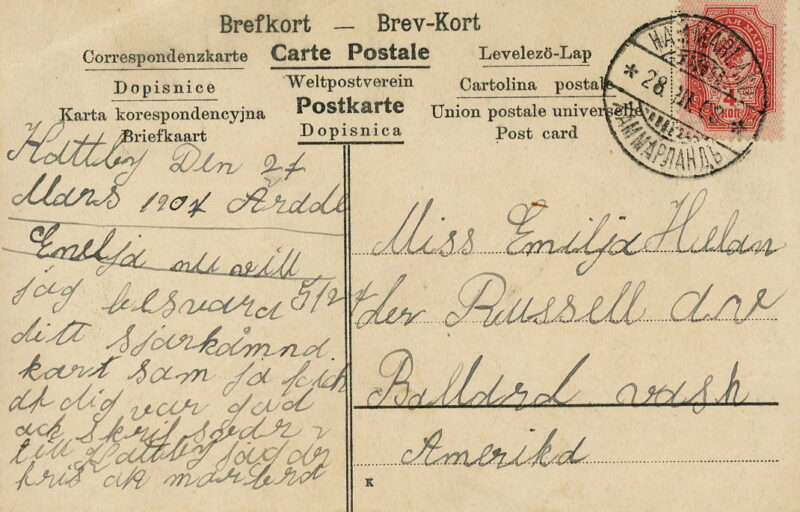
Many letters must have been written between Seattle and Åland to share news and make all the travel arrangements. Of all that correspondence, we have only a handful of letters from Åland to Seattle, written mainly by Eric Ulric, father of the sisters. I had these translated, and we can take a peek at life at the turn of the twentieth century in a place where the way of life had not changed very much for centuries.
Eric Helander did not imagine he was writing history when he talked about the failing potatoes and bringing in the meager harvest with scythes in 1901. In a letter written to Julia not long after she arrived in Seattle in 1901, her father writes about the poor harvest, thanking Julia for sending money and sharing news of the neighbors. Emelia was still at home on the Åland farm caring for her mother and would not leave for five more years.
Hammarland, Åland
Island September 5, 1901
My always remembered and never forgotten daughter Julia, who is so nice that you do not forget us. We received your letter a week ago, in which we found with such joy that you are so kind and send us money. We have to thank you so much for this. We are so happy when we get letters from you and even happier when we see your gifts. We have just finished with our haymaking, but there was plenty of hay. Then we harvested the fields [lit. cut, i.e. with scythes)] That was not big (yield) . . . not much bread for the year than it [has been] before. Like the potatoes are failing [falling sick] which is how it has been mostly this summer . . . how it’s running [in furrows], but God keeps us even when it runs. In every place earthquakes and thousands of people die in rainfall [lit. water fall] and earthquakes.
And the neighbors, they are arrogant and bear blame. They have three cows and three calves, and they are so so many both cows and calves so that it is just skin and bones on them . . . And Maspärsons Jenny is still unmarried. She will never have anyone either, though she so much wants to get married, just like others want to get married. And then I want to ask how it is going for Petter’s Kalian . . . You must send him our greetings, if he is alive. Is Kalagust married yet? Send our greetings to him also. . .
Fortunately we still have our health, thank God. We wish you the same great gift of our Lord. It is the greatest treasure we have on Earth. My dear Julia, you must not forget me as long as I live. And now we have to send our greetings and thank you and your husband so much.
E.U. Helander Goodbye
Be well. please write back
Another letter was sent to Julia from Åland in 1908 by her childhood friend, Viktoria. Thinking of Emelia, who by 1908 had been in Seattle for two years, Viktoria writes, “And Emelia, she never goes out of my memory . . . I felt sorry for her because she did not want to leave her home. But she was happy and even happier was old far far . . .” The reference to Grandfather Helander (Far Far) confirms our story about our grandmother never wanting to leave home and the deep attachment between Emelia and her Grandfather Helander. As Vivian puts it in her account,
“When Mother left home her Grandfather Helander felt very badly and he had told her that if she left, he would never stay on Åland Island. He came to this country shortly after Mother left Åland Island and went to live with his brother in Charleston, South Carolina. But Grandfather Helander only lived one year after coming to this country.”
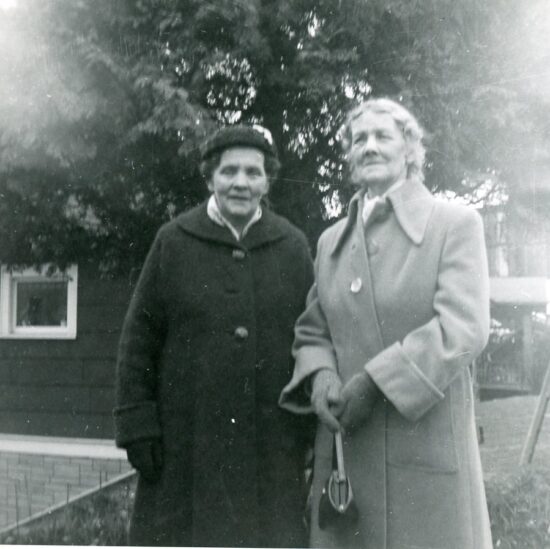
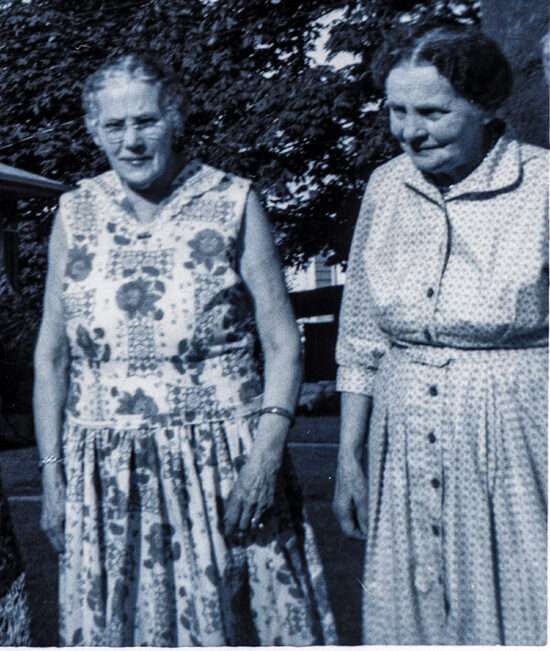
Johan Eric had first watched his younger son leave, followed by his four beloved grandchildren one by one, never to be seen again. Once his youngest grandchild Emelia left Åland in 1906, he had no reason to stay, and in June of 1907, Johan Eric Helander, age 84, obtained a passport and headed for America.
In a letter to Emelia dated March 1914, their father, Eric Ulrich, mentions he had heard from Hilda about how all of them got together. Several months later, as he became gravely ill in July, he wrote two letters in two days, one each to Emelia and Hilda, mailed in the same envelope. He thanked Emelia for sending pictures of her children and admitted that his health had worsened. In the letter to Hilda, he wrote frankly about his need for money, thanking her for what she had already sent. He also wrote of his hard situation to Hilda, “And fishing is so bad. It is getting worse year after year. And I do not have the strength to go out on the sea any more. And you asked how many years are left on the land.” How long their father had left on the land as a tenant farmer (crofter) as of 1914 isn’t clear, but Hilda knew it was important and asked about it. This is the last letter we have from Eric Ulric Helander, who died at age 66 not long after writing these letters.
In 1914, Edla Helander, Eric Helander’s second wife, writes to Emelia about his death and burial. She mentioned his gravesite: “Emelia you are asking where Papa is buried. He rests on the east side of the road when you went around Postad.”
When my father and aunt visited Åland Island in 1990, they found Edla’s grave site in one of the old churchyards and took a photo of it. At the time, they didn’t know where their grandfather was buried, nor did they have any way to find out. The clue was in this letter written in Swedish, found in 2008 packed away in their mother’s dresser, untranslated for nearly a hundred years.
If anyone travels to Hammarland, perhaps they will find a marker for Torpare Eric Helander on the east side of the road near Postad. Previous Helander ancestry can be traced back to the 1700s in the records of Bambole and Markusbole, small villages in Finström parish. Documents verifying the details are available on request.